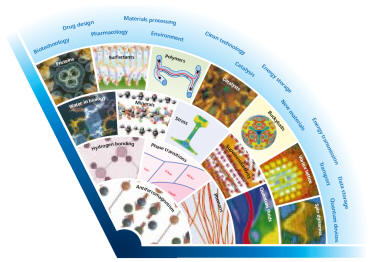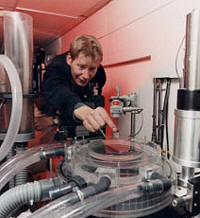ISIS is the world’s most powerful spallation neutron source and it has made an impressive impact upon condensed matter research. The second target station gives a large inter-disciplinary scientific community unrivalled access to a world-class facility.
Introduction
Neutron scattering has made a unique and fundamental contribution to the understanding of the structure and dynamics of condensed matter. Pioneering advances were highlighted in the award of the 1994 Nobel Prize in Physics to Brockhouse and Shull. Much of this early work was based on reactor sources, but in recent years, particularly through contributions from ISIS, the potential of accelerator based pulsed neutron sources has been firmly established. The advantages of neutron scattering studies - selectivity through isotopic labelling, the magnetic interaction, the ability to probe atomic motion, and the penetrability of the probe - are well established and documented. The effective and growing exploitation of ISIS over a broad range of condensed matter research has powerfully demonstrated the specific benefits of the time-of-flight technique in neutron scattering on pulsed sources. Such benefits include improved instrumental resolution, simultaneous wide coverage of both momentum and energy transfer, intrinsically low backgrounds, the ease of use of fixed geometry sample environment equipment, the high fluxes of epithermal neutrons and the broad spectral range. These features, coupled with the advantages of neutrons, have been responsible for the emergence of an impressive research programme, whose breadth covers topics at the forefront of physics, chemistry, materials science, and, more recently, earth and environmental sciences, engineering and biological sciences.
The developments at ISIS have had a particular impact on high resolution powder diffraction, magnetic inelastic scattering and the use of reflectometry to study surfaces and interfaces. Research at ISIS, using these diffraction and inelastic scattering techniques, has contributed significantly to our understanding of the properties of condensed matter, including polymers, surfactants and proteins at interfaces and in solution, giant magnetoresistance materials, high temperature superconductors and fullerenes. The neutron fluxes available at nuclear reactors are close to practical limits. In contrast, recent experience at ISIS has demonstrated that there is still considerable potential for the development of pulsed neutron sources.
Just as the advent of the high flux reactor at the Institut Laue Langevin (ILL), Grenoble, in the early 1970’s, with its dedicated cold neutron source, broadened considerably the appeal of neutron scattering, so the development of a Second Target Station at ISIS, optimised for long wavelength neutrons, will have a major impact on the study of complex condensed matter systems.
The Potential of a Second Target Station at ISIS
Performance gains of greater than an order of magnitude will be achieved for cold neutrons and high resolution instruments. This will be achieved by optimising both the target and moderator configurations on the second target station. Such potentially impressive gains in the capability of cold neutron scattering and high resolution studies will provide exciting new opportunities in the technologically significant areas of soft condensed matter, bio-molecular sciences, and advanced materials.

Acievements of neutron scattering: antiferromagnetism, hydrogen bonding, phase transitions, phonons...
View full-size image
In the areas of advanced materials and soft matter there is a distinct trend towards the study of complex, multi-component or multi-phase systems, the use of complex sample environments, and the investigation of non-equilibrium systems. The dimension scales of importance range from molecular to meso-scale. This dictates the need for a broad wavelength range with a particular emphasis on cold neutrons. Kinetic studies (ranging from chemical reactions to probing dynamic surface tension) require the same broad spectral range with higher fluxes of cold neutrons. Multi-component or multiphase systems are only tractable with the parametric studies possible using enhanced flux and high resolution. The introduction of the second target station at ISIS will provide a platform for such trends and offer unique, world class facilities for the UK scientific community. Significant developments in the scientific areas summarised below can be envisaged.
Proposed Instruments
The Second Target Station is based on proven designs and technologies. Its construction and commissioning can be completed in three years, assuming an optimal funding profile. The key areas of instrumentation that will benefit most are neutron reflectometry, small angle neutron scattering (SANS), very high resolution spectroscopy, non-crystalline diffraction, high resolution diffraction and large scale crystallography. An imaginative instrument suite to exploit these new opportunities is being developed. Seven key instruments have been identified to exploit the scientific opportunities: a low energy chopper spectrometer, Let; a high resolution powder diffractometer, HRPD-II; a small angle scattering instrument, Sans; a neutron reflectometer, Inter; a single crystal diffractometer, Lmx; a high energy resolution crystal analyser spectrometer Herbi; and a toroidal focusing mirror SANS instrument, Fm-sans. Further instrument concepts for the second target station are detailed in the section on instrumentation.

Adjustments being made on an experiment to study the adsorption of proteins in non-equilibrium conditions
An additional but important feature is that the relocation of instruments most suited to the second target station from the existing target station will provide new opportunities for instrumentation exploiting the characteristics of the high power target.
